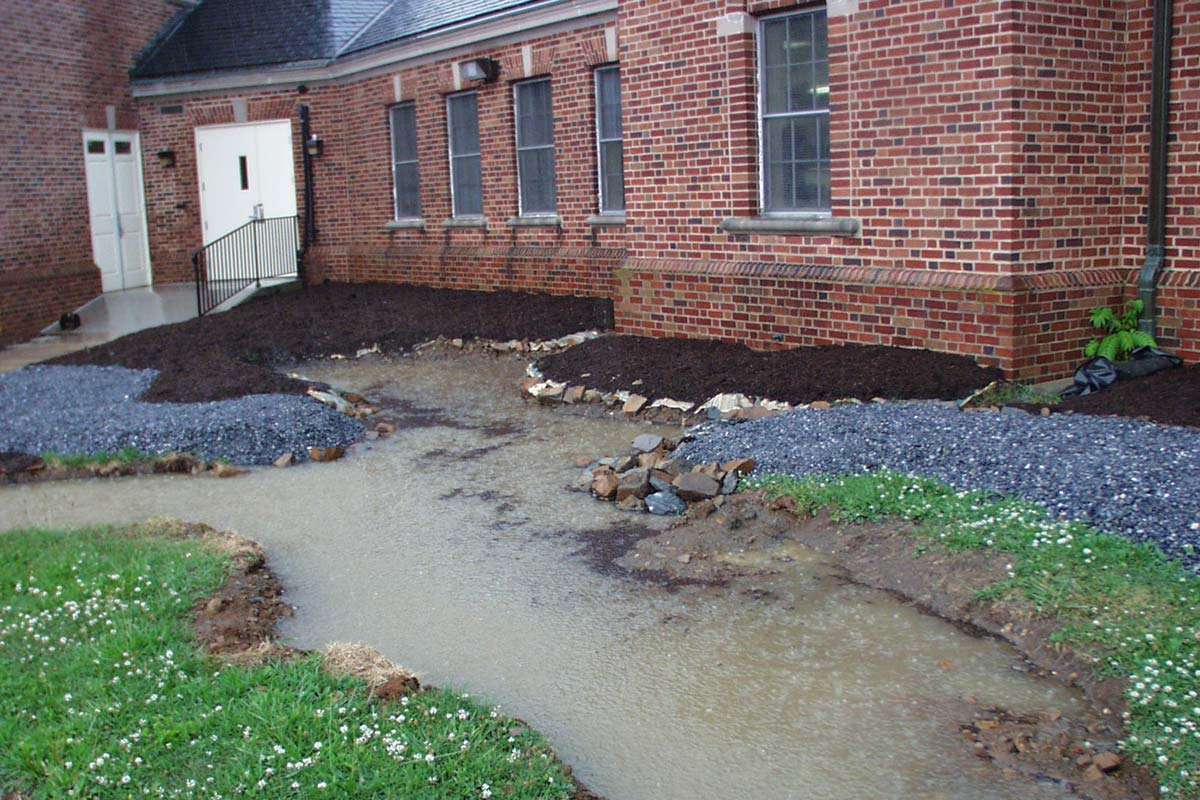News

What Happens When Stormwater Management Goes Wrong

By PCCD District Engineer Chris Meszler
Have you seen new construction taking place and noticed that the construction crew install pipes or grade in channels to divert stormwater into depressed areas, or basins, to hold water? This is done to make sure the new construction will manage the stormwater runoff it will produce due to the proposed development. When development takes place, there is typically a change in ground cover type, most commonly going from woods/meadow to impervious and maintained lawn.
When a new home or building is proposed to be built on a vacant property, the project site will need to make sure it manages the stormwater runoff. What is meant by stormwater management though? Stormwater management is when proposed development needs to analyze their stormwater runoff increases and manage them so as not to affect downstream properties and protect the receiving surface water. Stormwater runoff increases result when the ground cover type is changed. For example, when the existing cover is wooded, and the development will add parking lots. The woods ground cover will produce less runoff as the water has a better chance to infiltrate into the soil where pavement will produce more runoff as this surface allows no water to infiltrate. From a state level, there are three components to stormwater management. These components are the rate of the runoff leaving the site, the volume of runoff leaving the site, and the water quality of the runoff. The stormwater runoff needs to be managed during construction and post construction.

A Surface Infiltration Basin BMP (See citation 1)
Let’s break down the three components a little more to gain a better understanding of what we need to accomplish to meet the regulations of managing stormwater. The components of stormwater management are the requirements that the State has implemented to meet to receive the proper permitting to build. To meet the rate requirement, the rate of stormwater leaving the project site needs to be equal to or less than the pre-development condition. To meet the volume requirement, the increase of volume from the pre-development condition to the post-development condition for the 2-year/ 24-hour storm event must be managed on-site. The 2-year/ 24-hour storm event is a rainfall event that would produce the same amount of precipitation as a storm event that would have the probability of occurring once over a 2-year period lasting for 24 hours. The precipitation amount is measured as a depth in inches. For the water quality requirement, the water quality should be better in the post-development condition than in the pre-development condition.
Some ways that sites propose to manage their stormwater is to construct infiltration basins, wet ponds, and rain gardens to name a few. These best management practices (BMPs) can help the proposed development manage all three components. Sometimes multiple BMPs will be proposed to meet the stormwater management requirements.

A stormwater detention basin fails. (See citation 2)
One question we must ask ourselves is, what happens when stormwater management goes wrong? One of the first things that comes to mind is downstream properties being flooded. There could be potential washout of roadways, damage to neighboring properties, and a pollution event to the receiving surface water. These could happen because of stormwater not being managed properly or a failure of a proposed BMP due to improper installation or failure to maintain the BMP. When stormwater management fails and the downstream properties now receive this increase stormwater, the damage that can be done is costly to repair and can potentially be detrimental to the environment.

Sediment laden water flows to surface water and causes erosion. (See citation 3)
When the stormwater runoff isn’t properly managed and there is an increase in rate, this can cause accelerated erosion which can lead to sediment and debris on neighboring properties and sedimentation of streams and lakes. The sedimentation will cause the water to be cloudy which will affect the water temperature and the ecosystem. If the increase in volume isn’t managed, there will be a greater possibility of flooding downstream areas and overloading the existing conveyance measures. If the water quality of the stormwater runoff is not managed for suspended solids, phosphates, and nitrates, then the water quality of the receiving surface water may degrade. This degradation of water quality can lead to a decrease in aquatic life and the loss of a natural resource.

The Lackawaxen River looking north from Rowland Bridge in Pike County, Pa. (See citation 4)
How can we make sure that stormwater management doesn’t fail? During the permit review process, the District Engineer reviews the provided plans and calculations to make sure the proposed BMPs will meet the three components. When the project site goes to construction, there is an inspection of the BMP installation to make sure it is installed per the plans and that no issues are encountered in the field, helping to ensure the success of a BMP. This step of the process is called a critical stage and is conducted by the Engineer of Record or their representative. Once the development is in post construction condition, the inspection and maintenance of the BMP will help keep it functioning as designed and prevent failure.
When stormwater runoff is not managed, there can be minor to major impacts for downstream properties and to the receiving surface water. However, when stormwater runoff is managed per the regulations, it will maintain the existing drainage ways and help with the protection of the surface waters.
Photograph Citations
- Pennsylvania State University. Detention basins could catch more than stormwater. https://phys.org/news/2019-08-detention-basins-stormwater.html (August 14, 2020).
- Chester County Conservation District. Brandywine Red Clay Alliance. Lessons Learned: What happens when a stormwater detention basin fails? https://www.chesco.org/DocumentCenter/View/63303/BWinslow-Ludwigs-det-basin-presentation
- PA Environmental Digest Blog. Penn State Extension: What is Sediment, Why is Stormwater a Pollutant? https://paenvironmentdaily.blogspot.com/2019/12/penn-state-extension-what-is-sediment.html (December 21, 2019).
- Delaware Currents. Lackawaxen Basin earns top scores for water quality. https://delawarecurrents.org/2022/06/22/lackawaxen-basin-earns-top-scores-for-water-quality/ Photo by Meg McGuire. (June 22, 2022).
